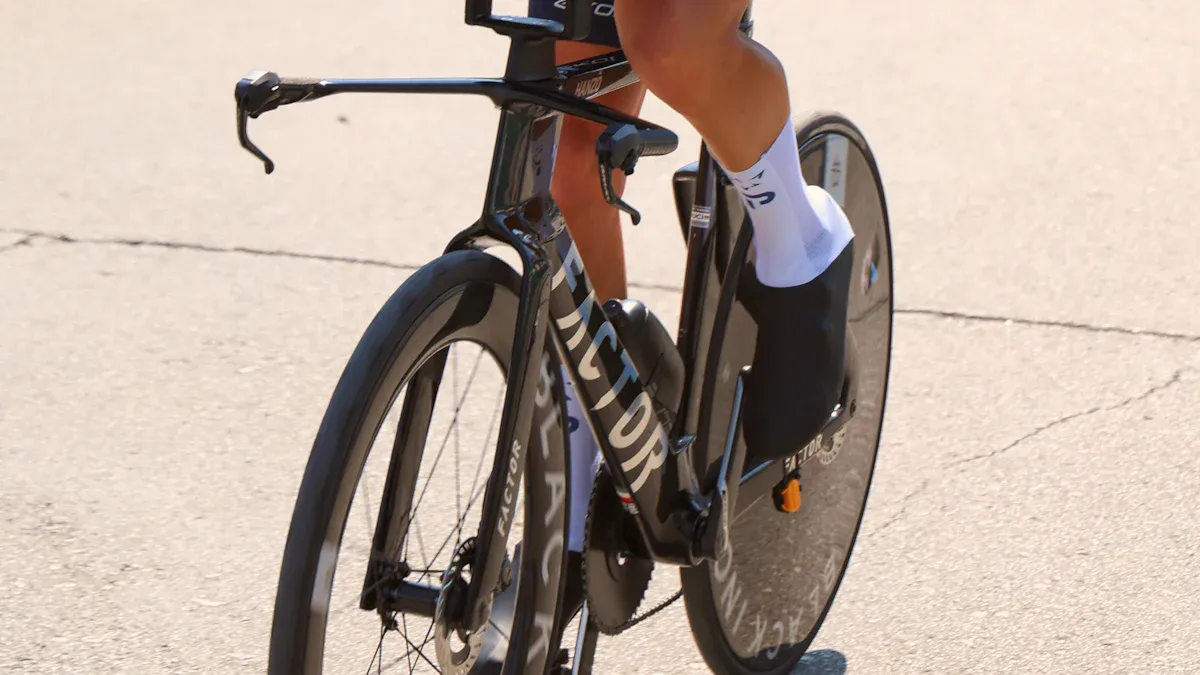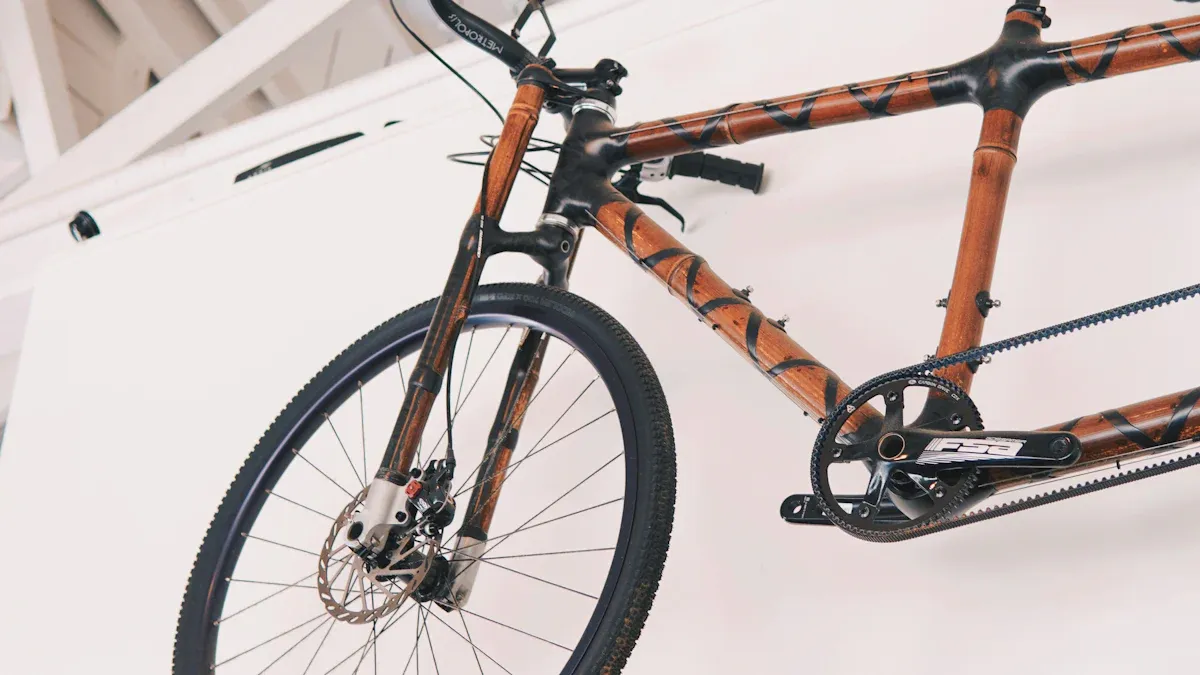
In 2025, learning how to build carbon frames, specifically making carbon bike frames, is very important. The bike industry is growing fast with carbon fiber. This growth is due to new ideas like better resin systems and improved ways to make things. These updates make frames lighter and stronger. This attracts buyers who want better performance and eco-friendly options for their rides.
Key Takeaways
Pick the best carbon fiber type for your bike frame. High-modulus fibers are stiff and good for speed. Standard fibers are more comfortable for easy rides.
Use CNC machining to make exact frame parts. This technology gives high accuracy and consistent quality. It helps improve bike performance.
Think about sustainability when building frames. Look at how carbon fiber affects the environment. Also, check out recycling options.
Making Carbon Bike Frame Materials

When you make carbon bike frames, the kind of carbon fiber you pick is very important. It affects how well the bike performs. Let’s look at the different types of carbon fibers and what makes each one special.
Types of Carbon Fibers
High-Modulus Carbon Fiber: This type is very stiff and light. It’s great for racers who want a quick ride. High-modulus carbon fibers are strong and resist impacts well. They are best for high-performance bikes.
Standard Carbon Fiber: This type is not as stiff as high-modulus fibers. However, it balances weight and cost well. It has enough strength for most cyclists and gives a smoother ride. Many casual riders like this option.
Choosing the right carbon fiber can change how your bike performs. For example, high-modulus carbon fiber frames are stiffer. This means they transfer power better. In contrast, standard-modulus carbon fiber frames are more comfortable but less stiff. This choice affects your ride and overall cycling fun.
Properties of Carbon Fiber
Knowing the properties of carbon fiber helps you make smart choices when building. Here’s a quick look at high-modulus and standard carbon fibers:
Property | High-Modulus Carbon Fiber | Standard Carbon Fiber |
|---|---|---|
Weight | Lightest choice, great for climbing | Good mix of weight and cost |
Stiffness | Most stiffness, quick ride | Can give a smoother, more comfortable ride |
Strength | Strongest and best impact resistance | Enough strength for most cycling needs |
Besides the type of carbon fiber, the resin system used is also very important. Here are some common resin types and what they do:
Resin Type | Characteristics | Applications |
|---|---|---|
Epoxy Resins | Strong and light, but heavier and weaker than carbon. | Often used in carbon fiber frames. |
Pre-preg | Gives even resin coverage, saves time, and allows better control. | Used in most frame making. |
Composite Epoxies | Mixed with glass or carbon nanotubes to boost performance. | Depends on the maker. |
Woven Fabrics | Better at handling damage and less likely to peel apart. | Used in complex shapes and parts. |
When picking materials for carbon bike frames, think about the environment too. Making carbon fiber uses a lot of energy and complicated chemicals. Unlike aluminum and steel, which can be recycled easily, carbon fiber frames often go to landfills. This is an important point to consider for sustainability in your frame building.
Custom Carbon Bike Frame Techniques

When you start making custom carbon bike frames, two important techniques stand out: CNC machining and using frame jigs. Both are key to making sure your frames are accurate, strong, and fit your needs.
CNC Machining Process
CNC machining is a big deal for custom carbon bike frames. This technology helps you make parts very precisely. Here’s why it’s important:
High Tolerances: CNC machining keeps tight tolerances. This is important for getting the exact measurements you want. This precision helps your bike frames balance better and transfer power smoothly.
Uniform Quality: With CNC, you get the same quality in all parts. This consistency makes it easier to create multiple frames that work the same way.
Complex Geometries: This technology lets you design complex shapes for specific performance needs. You can make unique frame designs that stand out and improve your riding experience.
But remember, the complexity of your design can affect costs. More detailed shapes take longer to machine, which can raise expenses. Also, using high-end machines for tighter tolerances can increase production costs. While aluminum is often chosen for its lower cost and easy machining, premium materials may be needed for certain functions, which can also raise costs.
Frame Jigs and Assembly
Using frame jigs is very important for putting together your custom carbon bike frames correctly. A frame jig holds all parts in their right place during assembly. This ensures everything lines up perfectly. Here are some key points to think about:
Material Choices: You can make jigs from different materials, like scrap wood or adjustable aluminum, based on your frame design needs. The jig must be strong enough to keep the frame parts in the right position.
Assembly Techniques: Different ways of putting things together affect how well your frames align and how strong they are. For example, the tube-to-tube assembly method improves precision and stiffness. This is important for keeping everything aligned. This method also helps absorb vibrations, making the frame stronger.
Adding extra layers of carbon fiber and resin at joints makes them last longer. This careful work makes sure your custom carbon bike frames not only look good but also perform really well.
In 2025, mastering these techniques will help you stand out in carbon frame construction. Whether you’re building for speed or comfort, knowing about CNC machining and good assembly methods will help you create bikes that riders will love.
Custom Bicycle Frames Assembly
When you put together custom bicycle frames, there are some cool techniques you can use. Two important methods are using bolts and the wrapped mitred tubes approach. Let’s look at each one.
Using Bolts for Assembly
Using bolts in your assembly gives you a special benefit. This method makes it easier to adjust and fix things later. You can change or tighten parts without taking apart the whole frame. But, it’s very important to use a torque wrench when you tighten bolts. If you over-tighten, it can cause cracks in the carbon layers. This can weaken the frame. Regular maintenance, like cleaning and checking for cracks, is very important for keeping your carbon bike strong. Following the recommended torque values helps keep the frame strong and working well.
Wrapped Mitred Tubes
The wrapped mitred tubes method is another good way to build custom bicycle frames. Here’s how it works:
Cut the tubes to fit together well.
Hold the tubes together temporarily to keep them in place.
Wrap the joints with carbon fiber for extra strength.
Use glue, like DP460 aerospace adhesive, to stick the tubes together for good.
Make sure everything lines up perfectly while bonding to avoid mistakes.
This method makes strong but light frames. The careful building reduces gaps and makes a strong bond between materials. Compared to traditional lugged or monocoque construction, wrapped mitred tubes are stronger and lighter. This makes them a favorite among builders.
In 2025, mastering these assembly techniques will help you stand out in custom bike building. Whether you want speed or comfort, these methods will help you make frames that riders will enjoy.
Performance and Durability of Custom Frames
When you make custom frames, your design choices are very important. They affect how well the bike works. Let’s look at how these choices change performance and how to make sure your frames last long.
Design Choices Impact
Your design features can change the bike’s speed and comfort. Here’s a quick look at some key design elements:
Design Feature | Impact on Aerodynamics |
|---|---|
Aero-shaped tubing | Reduces wind resistance, making the bike faster. |
Integrated components | Cuts down drag by making the frame smoother. |
Internal routing of cables | Hides wires and hoses from the wind, helping airflow. |
Choice of carbon fiber | Lets you adjust stiffness and weight for better speed. |
When you pick the right tube shapes and patterns, you can build a bike that feels great. For example, carbon fiber lets you arrange fibers in special ways. This helps you make parts stiff where needed while still keeping it comfy by reducing vibrations. Unlike metal frames, this method gives you a bike that works well without losing comfort.
Here are a few more points about design choices:
Carbon fiber is a top choice for bike frames because it is light and strong compared to other materials.
Special layup techniques help you shape carbon pieces to get the strength, weight, and ride feel you want.
High-strength, high-modulus carbon fiber improves performance, making your bike feel quick and lively.
Testing and Quality Assurance
After you make your custom frame, it’s very important to test it well. Quality checks help you find any problems before they happen on the road. Here are some common issues to watch for:
Carbon frames can get damaged and fail after a crash.
Riding in mud can wear down important parts like chainstays or seat stays.
Damage from impacts might not show right away, which can cause the resin to separate from the carbon.
To make sure your frames are strong, think about these testing methods:
Visual Inspections: Regularly look for cracks or signs of wear.
Load Testing: Apply pressure to see how the frame holds up.
Impact Testing: Simulate crashes to check how well the frame can take hits.
By focusing on good craftsmanship and careful testing, you can create custom frames that not only look nice but also work really well. Remember, how durable your custom frames are can help you stand out in the busy cycling market.
Learning how to build carbon frames is very important for your success in 2025. Here’s why you should use these methods:
Innovative Techniques: CNC machining and wrapped mitred tubes make your frames stronger and more precise.
Sustainability Focus: Using eco-friendly methods is becoming very important in frame building.
Customization Opportunities: Making frames fit specific needs helps them perform better.
As you explore this exciting area, remember that new carbon fiber technology will keep changing cycling. Accept these changes, and you’ll make bikes that riders will enjoy! 🚴♂️
FAQ
What are the benefits of custom carbon frames over alloy or steel?
Custom carbon frames are lighter and stiffer. They can be made to fit your riding style. This gives you better performance than alloy or steel.
How can I customize my carbon bike frame?
You can change your carbon bike frame by picking shapes, sizes, and materials. These should match your riding style and preferences.
Are carbon frames sustainable?
Carbon frames can harm the environment because they need a lot of energy to make. Some companies are looking into recycling options to help with sustainability.
See Also
The Rise of Carbon Bike Frames Among Cyclists in 2025
Exploring the Innovations of Carbon Fiber Bike Frame Technology
New Developments in Electric Bike Frames for 2025
